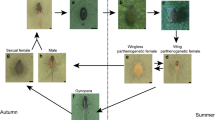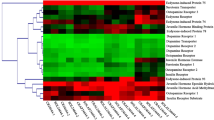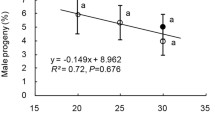Abstract
Aphids display divergent adult phenotypes, depending on environmental conditions experienced during their embyonic and nymphal stages in their complex life cycles. The plastic developmental mode is an extreme case of phenotypic plasticity, so-called “polyphenism”, in which discrete multiple phenotypes are produced based on a single genome. For example, winged and wingless adult females are derived from a single genotype. However, the developmental mechanisms producing these polyphenic traits according to the extrinsic stimuli, such as density conditions, still remain unknown. In this study, to analyze the developmental processes underlying the wing polyphenism, we extensively observed and compared wing development in the winged and wingless individuals in parthenogenetic generations of the aphid Acyrthosiphon pisum (Harris), using scanning electron microscopy and histological sectioning. At the first-instar stage, the wing primordia were observed both in the future winged (W) and wingless (WL) nymphs. Developmental differences can be seen from the second-instar stage, when wing primordia degenerate in the WL nymphs, while they develop and become more thickened in the W nymphs, suggesting that the developmental programs should be launched prior to this stage. Furthermore, during the third- to fifth-instar stages, wing buds and flight muscles were well developed in the W nymphs, while wing primordia completely disappeared in the WL ones. In addition, the observation on the detailed developmental process of wing primordia during the third-instar W nymphs showed that the wing buds become swollen especially at the basal part, even during the intermolt period. This was caused by the development of wing epithelia under the cuticle of this instar nymph. Actually on the surface of the cuticle of wing-bud bases, there were numerous furrows, which gradually expand during the intermolt period. The similar situation was also observed at the forth-instar nymphs, in which the wings are formed in the complicated manner inside the wing pads. Furthermore, the developmental process of flight muscles was also described in detail. These dynamic developmental differences between the wing morphs should be regulated under the gene expression cascades that switch according to environmental stimuli.








Similar content being viewed by others
References
Abouheif E, Wray GA (2002) Evolution of the gene network underlying wing polyphenism in ants. Science 297:249–252
Aoki S (1977) Colophina clematis (Homoptera, Pemphigidae), an aphid species with ‘soldiers’. Kontyu 45:276–282
Blackman RL (1987) Reproduction, cytogenetics and development. In: Minks AK, Harrewijn P (eds) Aphids: their biology, natural enemies and control. Elsevier, Amsterdam, pp 163–195
Braendle C, Caillaud MC, Stern DL (2005a) Genetic mapping of aphicarus—a sex-linked locus controlling a wing polymorphism in the pea aphid (Acyrthosiphon pisum). Heredity 94:435–442
Braendle C, Friebe I, Caillaud MC, Stern DL (2005b) Genetic variation for an aphid wing polyphenism is genetically linked to a naturally occurring wing polymorphism. Proc R Soc B 272:657–664
Braendle C, Davis GK, Brisson JA, Stern DL (2006) Wing dimorphism in aphids. Heredity 97:192–199
Brisson JA, Stern DL (2006) The pea aphid, Acyrthosiphon pisum: an emerging genomic model system for ecological, developmental and evolutionary studies. BioEssays 28:747–755
Brisson JA, Davis GK, Stern DL (2007) Common genome-wide patterns of transcript accumulation underlying the wing polyphenism and polymorphism in the pea aphid (Acyrthosiphon pisum). Evol Dev 9:338–346
Chapman RF (1998) The insects, structure and function, 4th edn. Cambridge University Press, Cambridge
Dixon AFG (1972) Fecundity of brachypterous mcropterous alatae in Drepanosiphum dixoni (Callaphididae, Aphididae). Entomol Exp Appl 15:335–340
Dixon AFG (1998) Aphid ecology, 2nd edn. Chapman & Hall, London
Ganassi S, Signa G, Mola L (2005) Development of the wing buds in Megoura viciae: a morphological study. Bull Insectol 58:101–105
Gilbert SF (2001) Ecological developmental biology: developmental biology meets the real world. Dev Biol 233:1–12
Gillott C (2005) Entomology, 3rd edn. Springer, Dordrecht
Hales DF (1976) Juvenile hormone and aphid polymorphism. In: Lüscher M (ed) Phase and caste determination in insects. Pergamon Press, Oxford, pp 105–115
Harrison RG (1980) Dispersal polymorphisms in insects. Ann Rev Ecol Syst 11:95–118
Heikinheimo O (1987) Wing polymorphism in Symydobius oblongus and Myzocallis myricae. In: Holman J, Pelikan J, Dixon AFG, Weismann L (eds) Population structure, genetics and taxonomy of aphids and thysanoptera. SPB Academic Publishing, Smolenice, pp 170–175
Heming BS (2003) Insect development and evolution. Cornell University Press, Ithaca
Ishikawa A, Miura T (2007) Morphological differences between wing morphs of two macrosiphini aphid species, Acyrtbosipbon pisum and Megoura crassicauda (Hemiptera, Aphididae). Sociobiology 50:881–893
Johnson B (1958) Embryonic cuticle in aphids. Aust J Sci 21:146
Johnson B, Birks PR (1960) Studies on wing polymorphism in aphids I. The developmental process involved in the production of the different forms. Entomol Exp Appl 3:327–339
Kitzmiller JB (1951) The time interval between determination and differentiation of wings, ocelli, and wing muscles in the aphid Macrosiphon sanborni (Gillette). Am Nat 84:23–50
Lees AD (1961) Clonal polymorphism in aphids. In: Kennedy JS (ed) Insesct polymorphism. Royal Entomological Society, London, pp 68–79
Lees AD (1966) The control of polymorphism in aphids. Adv Insect Phisiol 3:207–277
MacKay PA, Wellington WG (1977) Maternal age as a source of variation in the ability of an aphid to produce dispersing forms. Res Popul Ecol 18:195–209
Miura T (2005) Developmental regulation of caste-specific characters in social-insect polyphenism. Evol Dev 7:122–129
Miura T, Kamikouchi A, Sawata M, Takeuchi H, Natori S, Kubo T, Matsumoto T (1999) Soldier caste-specific gene expression in the mandibular glands of Hodotermopsis japonica (Isoptera: Termopsidae). Proc Natl Acad Sci USA 96:13874–13879
Miura T, Koshikawa S, Machida M, Matsumoto T (2004) Comparative studies on alate wing formation in two related species of rotten-wood termites: Hodotermopsis sjostedti and Zootermopsis nevadensis (Isoptera, Termopsidae). Insectes Soc 51:247–252
Müller CB, Williams IS, Hardie J (2001) The role of nutrition, crowding and interspecific interactions in the development of winged aphids. Ecol Entomol 26:330–340
Nijhout HF (1999) Control mechanisms of polyphonic development. BioScience 49:181–192
Nijhout HF (2003) Development and evolution of adaptive polyphenism. Evol Dev 5:9–18
Sabater-Muños B, Legeai F, Rispe C, Bonhomme J, Dearden P, Dossat C, Duclert A, Gauthier J-P, Ducray DG, Hunter W, Dang P, Kambhampati S, Martinez-Torres D, Cortes T, Moya A, Nakabachi A, Philippe C, Prunier-Leterme N, Rahbé Y, Simon J-C, Stern DL, Wincker P, Tagu D (2006) Large-scale gene discovery in the pea aphid Acyrthosiphon pisum (Hemiptera). Genome Biol 7:R21
Sameshima S, Miura T, Matsumoto T (2004) Wing disc development during caste differentiation in the ant Pheidore megacephala (Hymenoptera: Formicidae). Evol Dev 6:336–341
Shull AF (1938) Time of determination and time of differentiation of aphid wings. Am Nat 72:170–179
Stern DL, Foster WA (1996) The evolution of soldiers in aphids. Biol Rev 71:27–79
Sutherland ORW (1969) The role of crowding in the production of winged forms by two strains of the pea aphid, Acyrthosiphon pisum. J Insect Phisiol 15:1385–1410
Sutherland ORW (1970) An intrinsic factor influencing the alate production by two strains of the pea aphid, Acyrthosiphon pisum. J Insect Physiol 16:1349–1354
Tagu D, Sabater-Muñoz B, Simon J-C (2005) Deciphering reproductive polyphenism in aphids. Invertebr Reprod Dev 48:71–80
Tsuji H, Kawada K (1987) Development and degeneration of wing buds and indirect flight muscles in the pea aphid (Acyrthosiphon pisum (Harris)). Jpn J Appl Entomol Zool 31:247–252
Waddington CH (1941) The genetic control of wing development in Drosophila. J Genet 41:75–139
West-Eberhard MJ (2003) Developmental plasticity and evolution. Oxford University Press, Oxford
White WS (1946) The environmental conditions affecting the genetic mechanism of wing production in the chrysanthemum aphid. Am Nat 80:245–270
Whitten J (1968) Metamorphic changes in insects. In: Etkin W, Gilbert LI (eds) Metamorphosis: a problem in developmental biology. Appleton-Century-Crofts, New York, pp 43–105
Wilkinson TL, Ishikawa H (2000) Injection of essential amino acids substitutes for bacterial supply in aposymbiotic pea aphids (Acyrthosiphon pisum). Entomol Exp Appl 94:85–91
Wilson ACC, Dunbar HE, Davis GK, Hunter WB, Stern DL, Moran N (2006) A dual-genome microarray for the pea aphid, Acyrthosiphon pisum, and its obligate bacterial symbiont, Buchnera aphidicola. BMC Genomics 7:50
Acknowledgments
We are grateful to S. Koshikawa, R. Cornette and T. Matsumoto for their valuable comments on the study and assistance in various experiments. The authors also thank D. Stern for his valuable comments and careful editing of the manuscript. Thanks are also due to T. Fukatsu and A. Nakabachi for providing aphid strains. This work was supported by Grants-in-Aid for Scientific Research (Nos. 15687001, 18047002 and 18370007) from the Ministry of Education, Culture, Sports, Science and Technology of Japan. This paper is dedicated to the Prof. Hajime Ishikawa of blessed memory.
Author information
Authors and Affiliations
Corresponding author
Rights and permissions
About this article
Cite this article
Ishikawa, A., Hongo, S. & Miura, T. Morphological and histological examination of polyphenic wing formation in the pea aphid Acyrthosiphon pisum (Hemiptera, Hexapoda). Zoomorphology 127, 121–133 (2008). https://doi.org/10.1007/s00435-008-0057-5
Received:
Revised:
Accepted:
Published:
Issue Date:
DOI: https://doi.org/10.1007/s00435-008-0057-5




